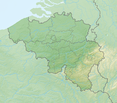Ostend radio
|
Ostend radio
OST and OSU
|
||
|---|---|---|
| Basic data | ||
| Place: | Middelkerke | |
| Province: | West Flanders | |
| Region: | Flanders | |
| Country: | Belgium | |
| Coordinates: 51 ° 10 ′ 56.6 " N , 2 ° 48 ′ 27.7" E | ||
| Use: | Telecommunication system , military use, coast radio station | |
| Accessibility: | Transmission system not accessible to the public | |
| Owner : | Belgian Ministry of Defense | |
| Data on the transmission system | ||
| Number of towers / masts: | 3 | |
| Height of the towers / masts : | 65 m | |
| Waveband : | AM station | |
| Send types: | Directional radio , mobile marine radio | |
| Position map | ||
|
|
||
Ostend Radio ( call signs : OST and OSU ) is the Belgian coastal radio station . It is one of the largest remaining coastal radio stations in Europe. Ostend Radio has an important role to play following the closure of many coast stations in the Netherlands , France and the United Kingdom.
history
The 3.6 hectare site of the transmitter is located in a nature reserve between dunes near Middelkerke in Flanders . The 65 m high transmitter masts can be seen in a wide area around the station. the “Radio Communications Services” of the Belgian Ministry of Defense now operates Ostend Radio.
The system was initially operated by "RTT", the "Regie van Telegraaf en Telefoon", and later by "Belgacom", the former Belgian telecommunications company. In April 1997 the whole system was transferred to "BIPT", the "Belgian Institute of Postal Services and Telecommunications" and in 2001 finally to the Belgian Ministry of Defense.
The Middelkerke station and the Ruiselede (Wingene) transmitting station together with the Oudenburg receiving station were part of the RMD, “Radio Maritime Services”. the main building was in "Perronstraat" in Ostend .
After the First World War , the Ostend Radio coast station (call sign OST) was housed in a wooden barracks next to the Ostend water tower. The tower was used as an antenna mast. When the building became too small, the radiotelephone service moved to a small building for the nautical service in “Torhoutsesteenweg”, near the airport. In 1930 Oostende Radio started experiments in telephony using the duplex method .
After the Second World War in 1949, Middelkerke, the station was equipped with two additional medium wave transmitters and a third transmission mast.
Today Ostend Radio has two tasks: On the one hand, it ensures safety at sea, as there is constant monitoring of the emergency channels. The second task is the commercial mediation of communications at sea, which is gradually decreasing with the technology available ( GSM and satellite telephony ). Direct communication remains important for military use, as satellites are usually sovereign switching technology.
Web links
- Images accessed January 8, 2013.
- Documentation , accessed January 8, 2013.

